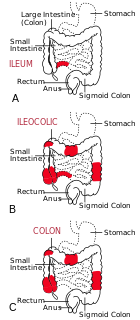Pasteurization or pasteurisation is a process in which water and certain packaged and non-packaged foods are treated with mild heat, usually to less than 100 °C (212 °F), to eliminate pathogens and extend shelf life. The process is intended to destroy or deactivate organisms and enzymes that contribute to spoilage or risk of disease, including vegetative bacteria, but not bacterial spores. Since pasteurization is not sterilization, and does not kill spores, a second "double" pasteurization will extend the quality by killing spores that have germinated.

A dairy is a business enterprise established for the harvesting or processing of animal milk – mostly from cows or buffaloes, but also from goats, sheep, horses, or camels – for human consumption. A dairy is typically located on a dedicated dairy farm or in a section of a multi-purpose farm that is concerned with the harvesting of milk.

Crohn's disease is a type of inflammatory bowel disease (IBD) that may affect any segment of the gastrointestinal tract from the mouth to the anus. Symptoms often include abdominal pain, diarrhea, fever, and weight loss. Other complications outside the gastrointestinal tract may include anemia, skin rashes, arthritis, inflammation of the eye, and tiredness. The skin rashes may be due to infections as well as pyoderma gangrenosum or erythema nodosum. Bowel obstruction may occur as a complication of chronic inflammation, and those with the disease are at greater risk of bowel cancer.

Ulcerative colitis (UC) is a long-term condition that results in inflammation and ulcers of the colon and rectum. The primary symptoms of active disease are abdominal pain and diarrhea mixed with blood. Weight loss, fever, and anemia may also occur. Often, symptoms come on slowly and can range from mild to severe. Symptoms typically occur intermittently with periods of no symptoms between flares. Complications may include megacolon, inflammation of the eye, joints, or liver, and colon cancer.

Irritable bowel syndrome (IBS) is a group of symptoms—including abdominal pain and changes in the pattern of bowel movements without any evidence of underlying damage. These symptoms occur over a long time, often years. It has been classified into four main types depending on whether diarrhea is common, constipation is common, both are common, or neither occurs very often. IBS negatively affects quality of life and may result in missed school or work. Disorders such as anxiety, major depression, and chronic fatigue syndrome are common among people with IBS.

Mycobacterium is a genus of Actinobacteria, given its own family, the Mycobacteriaceae. Over 190 species are recognized in this genus. This genus includes pathogens known to cause serious diseases in mammals, including tuberculosis and leprosy in humans. The Greek prefix myco- means "fungus," alluding to the way mycobacteria have been observed to grow in a mold-like fashion on the surface of cultures. It is acid fast and cannot be stained by the Gram stain procedure.

Inflammatory bowel disease (IBD) is a group of inflammatory conditions of the colon and small intestine. Crohn's disease and ulcerative colitis are the principal types of inflammatory bowel disease. Crohn's disease affects the small intestine and large intestine, as well as the mouth, esophagus, stomach and the anus, whereas ulcerative colitis primarily affects the colon and the rectum.
Paratuberculosis is a contagious, chronic and sometimes fatal infection that primarily affects the small intestine of ruminants. It is caused by the bacterium Mycobacterium avium subspecies paratuberculosis. Infections normally affect ruminants, but have also been seen in a variety of nonruminant species, including rabbits, foxes, and birds. Horses, dogs, and nonhuman primates have been infected experimentally. Paratuberculosis is found worldwide, with some states in Australia being the only areas proven to be free of the disease.

Yersinia enterocolitica is a Gram-negative bacillus-shaped bacterium, belonging to the family Yersiniaceae. It is motile at temperatures of 22–29° C (72-84°F), but becomes nonmotile at normal human body temperature. Y. enterocolitica infection causes the disease yersiniosis, which is an animal-borne disease occurring in humans, as well as in a wide array of animals such as cattle, deer, pigs, and birds. Many of these animals recover from the disease and become carriers; these are potential sources of contagion despite showing no signs of disease. The bacterium infects the host by sticking to its cells using trimeric autotransporter adhesins.
Flash pasteurization, also called "high-temperature short-time" (HTST) processing, is a method of heat pasteurization of perishable beverages like fruit and vegetable juices, beer, kosher wine, and some dairy products such as milk. Compared with other pasteurization processes, it maintains color and flavor better, but some cheeses were found to have varying responses to the process.

Mycobacterium avium-intracellulare infection (MAI) is an atypical mycobacterial infection, i.e. one with nontuberculous mycobacteria or NTM, caused by Mycobacterium avium complex ("MAC"), which is made of two mycobacteria species, M. avium and M. intracellulare. This infection causes respiratory illness in birds, pigs, and humans, especially in immunocompromised people. In the later stages of AIDS it can be very severe. It usually first presents as a persistent cough. It is typically treated with a series of three antibiotics for a period of at least six months.
Dysbiosis is a term for a microbial imbalance or maladaptation on or inside the body, such as an impaired microbiota. For example, a part of the human microbiota, such as the skin flora, gut flora, or vaginal flora, can become deranged, with normally dominating species underrepresented and normally outcompeted or contained species increasing to fill the void. Dysbiosis is most commonly reported as a condition in the gastrointestinal tract, particularly during small intestinal bacterial overgrowth (SIBO) or small intestinal fungal overgrowth (SIFO).

Mycobacterium abscessus complex (MABSC) is a group of rapidly growing, multidrug-resistant non-tuberculous mycobacteria (NTM) species that are common soil and water contaminants. Although M. abscessus complex most commonly cause chronic lung infection and skin and soft tissue infection (SSTI), the complex can also cause infection in almost all human organs, mostly in patients with suppressed immune systems. Amongst NTM species responsible for disease, infection caused by M. abscessus complex are more difficult to treat due to antimicrobial drug resistance.
Mycobacterium avium is a species of the phylum Actinobacteria, belonging to the genus Mycobacterium.
Mycobacterium avium complex is a group of mycobacteria comprising Mycobacterium intracellulare and Mycobacterium avium that are commonly grouped together because they infect humans together; this group, in turn, is part of the group of nontuberculous mycobacteria. These bacteria cause disease in humans called Mycobacterium avium-intracellulare infection or Mycobacterium avium complex infection. This group should not be confused with Mycobacterium tuberculosis complex.
Mycobacteria that form colonies clearly visible to the naked eye in more than 7 days on subculture are termed slow growers.
Mycobacterium porcinum is a species of Mycobacterium.
Functional Molecular Infection Epidemiology (FMIE) is an emerging area of medicine that entails the study of pathogen genes and genomes in the context of their functional association with the host niches and the complex interactions they trigger within the host immune system to culminate in varied outcomes of the infection. This can also be defined as the correlation of genetic variations in a pathogen or its respective host with a unique function that is important for disease severity, disease progression, or host susceptibility to a particular pathogen. Functional epidemiology implies not only descriptive host-pathogen genomic associations, but rather the interplay between pathogen and host genomic variations to functionally demonstrate the role of the genetic variations during infection.
Campylobacter concisus is a Gram-negative, highly fastidious, mesophilic bacterium that grows under both anaerobic and microaerobic conditions with the presence of hydrogen significantly aiding growth. Motile, with either unipolar or bipolar flagella, the organisms have a characteristic spiral/corkscrew appearance and are oxidase-positive. Although the human oral cavity is the natural colonization site of the bacterium, C. concisus may also colonize the intestinal tract of some individuals. In particular, several studies have reported higher intestinal prevalence of C. concisus in patients with IBD compared to healthy controls, which has led to current speculation of the bacterium's implication in the induction of Crohn's disease.
Infections associated with diseases are those that are associated with possible infectious etiologies, that meet the requirements of Koch's postulates. Other methods of causation are described by the Bradford Hill criteria and Evidence-based medicine. Koch's postulates have been altered by some epidemiologists based upon sequence-based detection of distinctive pathogenic nucleic acid sequences in tissue samples. Using this method, absolute statements are not always possible regarding causation. Since this is true, higher amounts of distinctive pathogenic nucleic acid sequences would be in those exhibiting disease compared to controls since inoculating those without the pathogen is unethical. In addition, the DNA load should drop or become lower with the resolution of the disease. The distinctive pathogenic nucleic acid sequences load should also increase upon recurrence.








